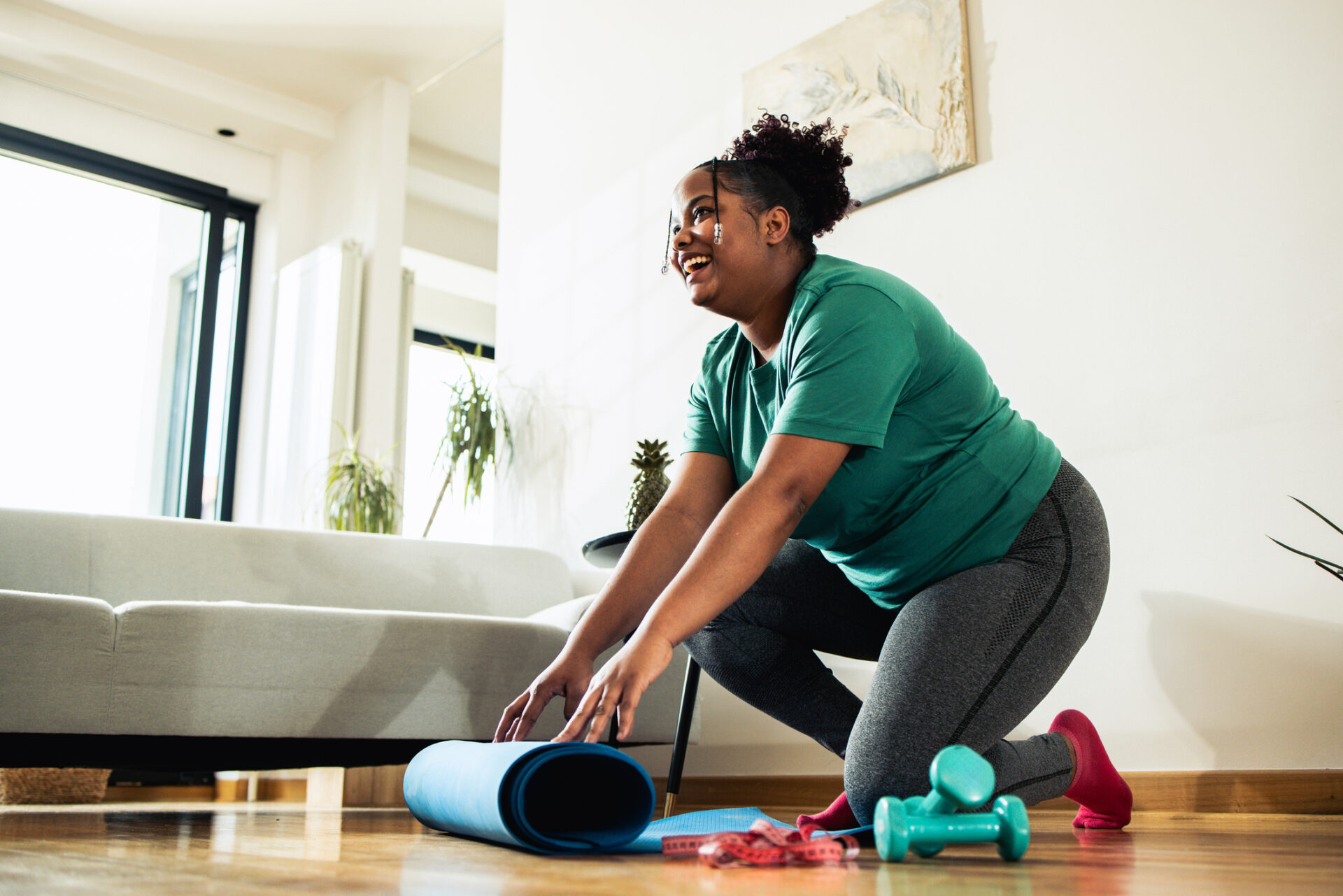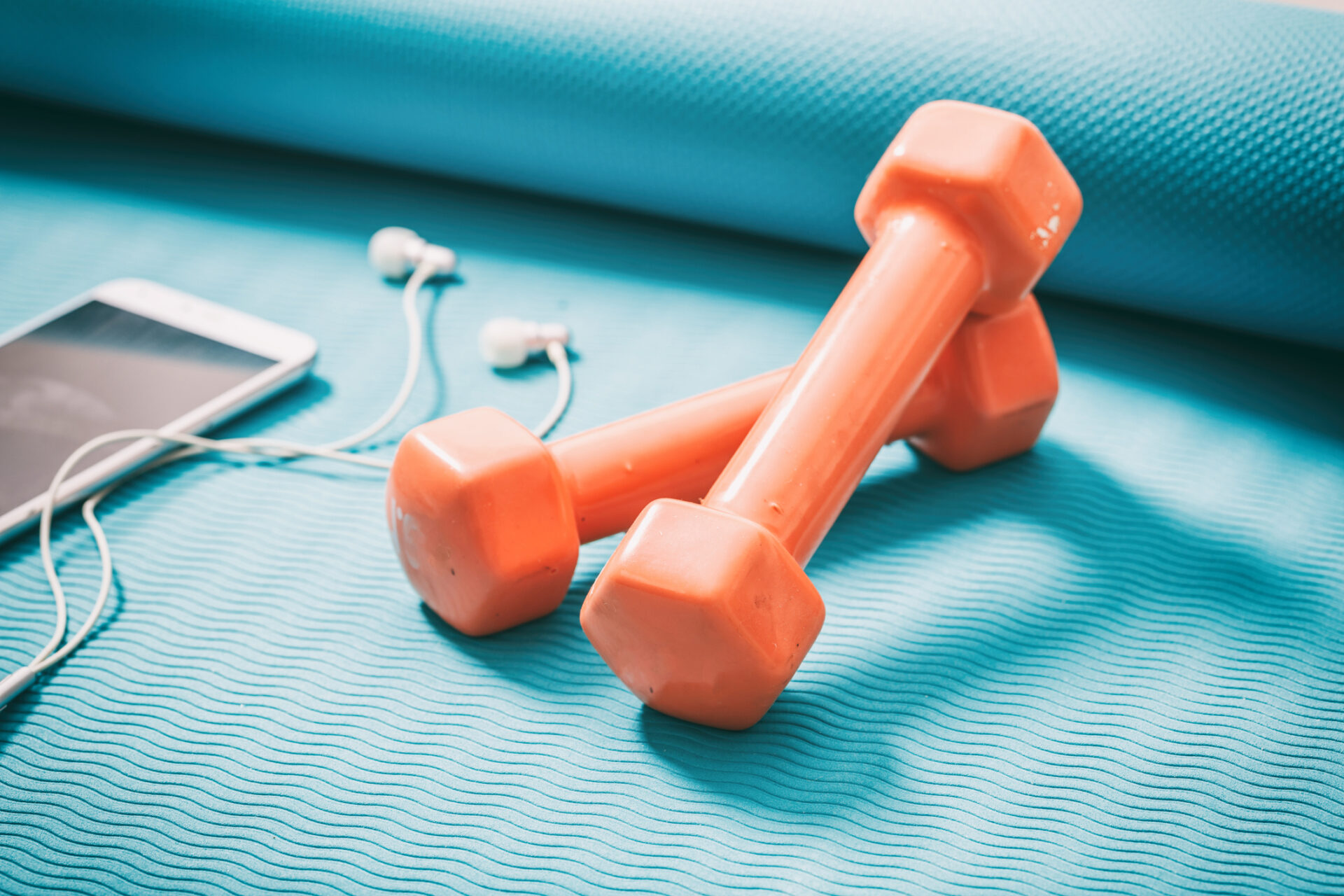How Do Resistance Bands Work? A Guide For Beginners
Article posted in: Fitness

If you’re new to activity, starting a strength training routine can seem daunting — but it doesn’t have to be!
Resistance bands are an effective and inexpensive alternative to weights and a gym membership. They’re also portable—you can easily slip them into your bag and take them anywhere for a quick, quality workout. So grab your resistance bands and get ready for an efficient workout that builds muscle in a versatile and fun way!
Remember to always consult your health care provider before beginning an exercise program.
What are Resistance Bands?

Resistance bands are either flat or tubular and come in various resistance levels. A good rule of thumb is that the lighter the band, the less tension. So if you’re starting a strength training program, choose green (light resistance) or red (medium resistance).
Having a variety of tensions provides options to vary your routine by muscle group. You also can purchase resistance bands as a set with multiple tensions included.
Resistance bands make it easy to build strength and gain flexibility from the comfort of your home or hotel room. The benefits of resistance bands extend beyond building strength — they help mobility, stability and balance, and flexibility.
What started as a therapy for patients rehabilitating post-injury has gained mainstream popularity—they are portable, lightweight, easy to store and effective. While resistance bands provide similar benefits to traditional free weights, they can offer more versatility and aren’t as clunky.
Health Benefits of Strength Training
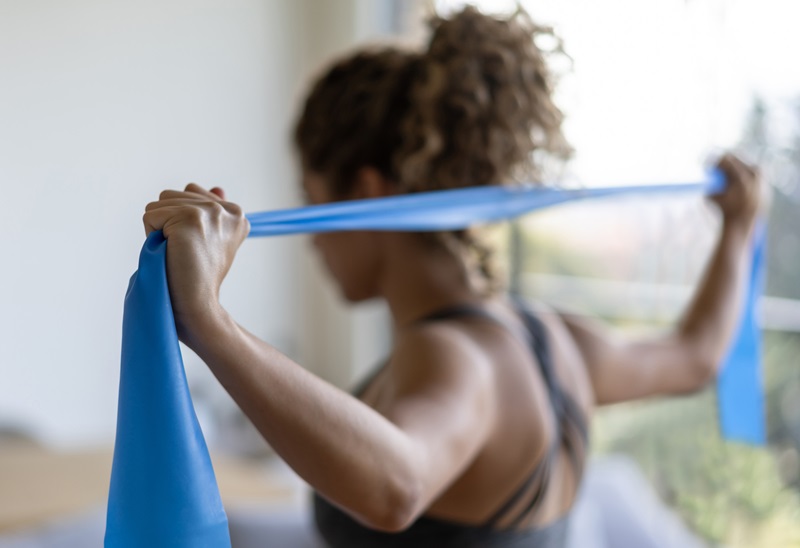
The American Heart Association recommends strength training at least twice a week. Jenny Craig plans incorporate strength training three times a week for approximately 30 minutes (combined with a daily 8,000 steps).
And don’t worry about getting “bulky” from strength training — using resistance bands will help build strength and elongate muscles. There are numerous benefits to including strength training in your regular fitness and activity routine (not even counting the added benefit of feeling empowered and strong!).
- Maintaining muscle tissue: While some people want to build muscle, toning and maintaining the strength you have—use it or lose it approach—can motivate and help with consistency. Staying strong and maintaining muscle has benefits for us now and also as we age.
- Increased strength and decreased risk of injury: Being strong and muscular makes picking up your 4-year-old easier and more fun (think less strain on your back)! It also makes everything you do a little bit safer—you gain stability with strength which makes you less likely to fall or injure yourself.
- Improved bone health: When your muscles are actively pulling against the resistance of a band, lifting a weight or supporting your body weight, that stress stimulates bone turnover and growth, which is essential to maintain what you have and even increase bone density over time.
- Decrease body fat: Muscle is the engine of our metabolism and helps burn more calories even when chilling out. Muscle tissue burns more calories than any other tissue in our bodies, and even modest gains help manage body fat and weight over time.
How Do Resistance Bands Work?
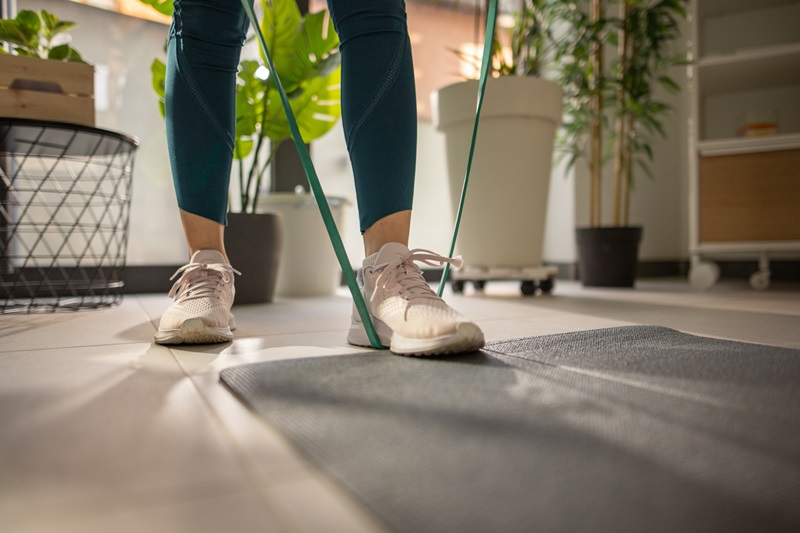
Resistance bands do just that — they provide muscle resistance created by elastic force. When you pull on the band, you create tension, and your muscles must work harder to continue the movement. The more you stretch the elasticized band, the greater the resistance it provides, and that means your muscles have to work that much harder to pull against the increasing resistance.
Conversely, with free weights, resistance is created by gravity, and you move in a vertical plane. Using resistance bands, you can move in both vertical and horizontal planes, providing complementary benefits if you also use free weights. Incorporating resistance band training into your existing fitness regimen can work muscles from various angles, also helping to ward off injury.
How Do You Use Resistance Bands?

Adults of any age or fitness level can start using resistance bands and reap benefits. If you’re used to bodyweight exercises, they will provide you with an extra challenge without the pressure on your joints compared to free weights or kettlebells. Many trainers recommend using them to focus on smaller stabilizing muscles that you may not typically target in your regular fitness routine.
Getting Started
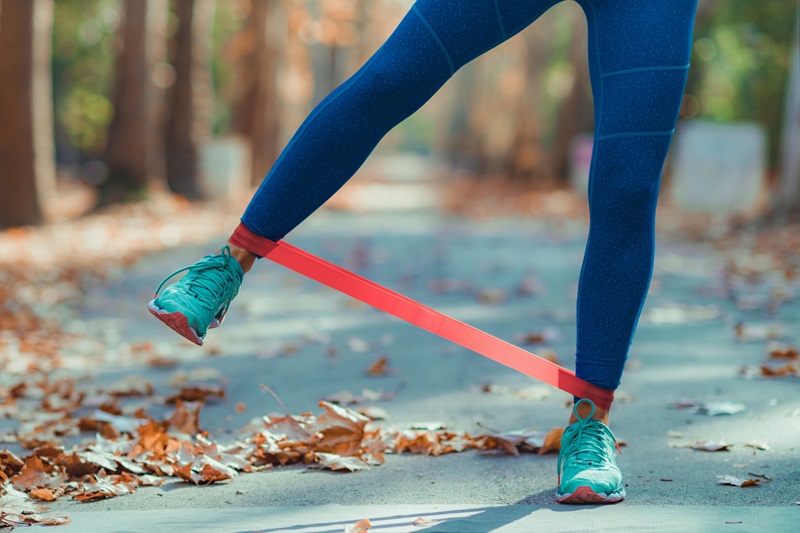
Here are some activities using resistance bands to incorporate into your strength training routine. Turning up some of your favorite music will make it even more fun.
Resistance Band Bicep Curl
Bicep curls are fun because you can look down and see your bicep muscles working and strengthening.
- Stand with both feet on a long resistance or body band, holding one end in each hand, with your arms extended, palms facing upward.
- Slowly curl your hands up toward your shoulders, squeezing your biceps while keeping your elbows tight to the sides of your body.
- Slowly lower your hands back to the starting position. This is one rep. Depending on your fitness level, complete 8-12 reps. Repeat 2-3 times.
Resistance Band Lateral Lunge
The lateral lunge is a favorite of many because it provides a nice counter-movement to the typical lateral movements we do when walking, jogging or cycling. For this activity, you will need a resistance band that is a closed loop.
- Loop a long resistance or body band around both ankles, and stand up straight with feet about hip-width distance apart (about two fists wide).
- Hold your hands together in front of your chest or rest them on your hips. This is the starting position.
- Take a step to the right — about 2 feet.
- When your foot hits the ground, hinge forward at the hips, push your butt back, and bend your right knee to lower into a lunge. Keep your knee at a 90-degree angle.
- Pause for a second, and then push off your right leg to return to the starting position.
- Repeat on the other leg. That is one rep.
- Depending on your fitness level, complete 8-12 reps. Repeat 2-3 times.
Resistance Band Pull-Apart
This exercise will work the shoulders and upper back.
- Stand with feet about hip-width distance (about two fists wide).
- Hold a resistance band with both hands in front of your body at shoulder height.
- Grip the band so that there is about a foot in between your hands. This is the starting position.
- Slowly pull the band apart so that your hands move to your sides, keeping them at shoulder height.
- Bring your hands, in a controlled movement, back to the starting position. This is one rep.
- Depending on your fitness level, complete 8-10 reps. Repeat twice.
Resistance Band Squat
Squats work your glutes and your quads (front of thighs).
- Stand on the resistance band and grab both handles. Stand with your feet about hip-width distance apart (about two fists). If that is uncomfortable, try placing your feet wider, about shoulder-width apart. Toes are facing forward. This is the starting position.
- Bend your knees and push your hips back as you lower into a squat.
- Squeeze your core, lift your chest, and keep your back flat.
- Push through your heels to stand up to the starting position.
- Squeeze your glutes at the top. That is one rep.
- Depending on your fitness level, complete 8-12 reps. Repeat 2-3 times.
Why You Should Add Resistance Bands to Your Strength Training Routine
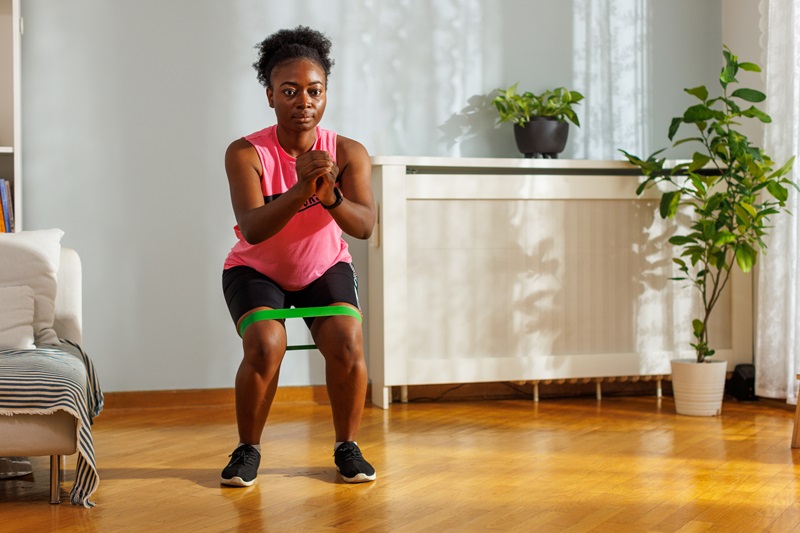
Incorporating strength training into your current fitness routine with resistance bands is fun, cost-effective, and simple. Coupled with cardio, it’s a great way to effectively support your weight loss efforts. What’s great is that there are so many different exercises to try using the portable bands, which will help keep your activity routine fun and exciting.
How Can I Incorporate More Resistance Band Training into My Activity Plan?
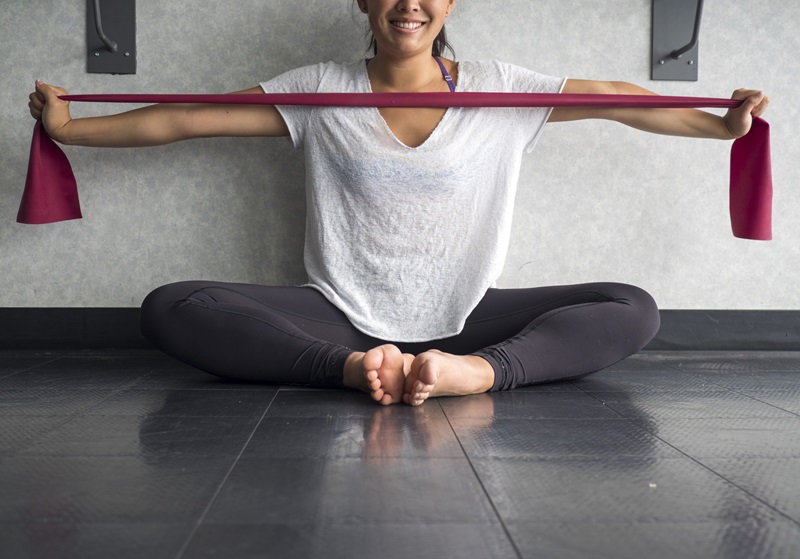
Jenny Craig integrates activity plans into its holistic approach to weight loss, along with meal plans, hydration, healthy living guidance and digital tools. This in turn allows you to monitor your progress over time and also help create healthy habits for life.


